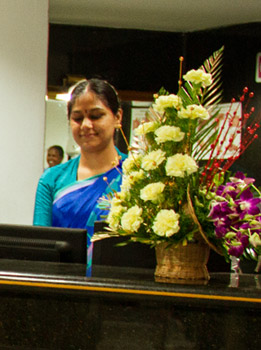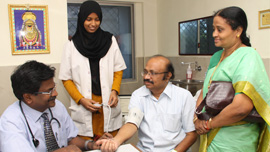Clinical Focus
Processes and Procedures Carried Out In the Blood Bank Includes:
- Donor Blood Collection
- Blood Component Preparation & Storage: Almost hundred percent of blood that is collected is separated into components. Equipment for preparation and storage of blood and components at appropriate temperatures are available. This ensures optimal utilization of donor blood.
- Blood Irradiation
- Plateletpheresis & Peripheral Blood Stem Cell Collection by Apheresis
- Train doctors for an MD course in Immunohaematology and Blood Transfusion (three years full-time course) which is recognised by the Medical Council of India.
Who Are The Blood Donors?
All blood donors are volunteers. However, sometimes, a patient may want to donate blood a couple of weeks before undergoing surgery, so that his or her blood is available in case of a blood transfusion. Donating blood for yourself is called an autologous donation. Volunteer blood donors must pass certain criteria. including the following:
- Must be at least 18 years of age, or in accordance with state law
- Must be in good health
- Must weigh at least 45 Kgs
- Must pass the physical and health history examination given prior to donation
Donor comfort is foremost in our minds and hence utmost care is provided to them before, during and after donation. The same is well exemplified in the donor waiting lounge, bleeding room and refreshment area. The donor is monitored throughout the blood collection process.
If you wish to direct your donation to a specific patient (i.e. Family Member), you will need to complete the form designed for this purpose. Blood is reserved for two weeks and blood must be donated 48 working hours before use. It is recommended that prospective donors eat prior to giving blood. After donation normal daily activities may resume. We do recommend that donors avoid lifting heavy weights or performing strenuous exercise for several hours. You may donate platelets and plasma by apheresis up to 24 times a year.
What Are The Components of Blood?
While blood, or one of its components, may be transfused, each component serves many functions, including the following:
- Red blood cells - These cells carry oxygen to the tissues in the body and are commonly used in the treatment of anaemia.
- Platelets - They help to arrest bleeding and are used in the treatment of leukaemia and other forms of cancer.
- White blood cells - These cells help to fight infection and aid in the immune process.
- Plasma - Is the watery, liquid part of the blood in which the red blood cells, white blood cells, and platelets are suspended. Plasma is needed to carry the blood contents through the bloodstream. The functions of Plasma are:
Maintains oncotic pressure
Provides factors for blood clotting
Balances the levels of sodium and potassium
- Cryoprecipitate AHF (Anti-Haemophilic Fraction) - The portion of the plasma, which contains clotting factors that help to control bleeding.
Blood Irradiation
Blood irradiation is done to inactivate T-lymphocytes present in the donated blood that may cause graft-versus-host disease which is a serious adverse effect.
Plateletpheresis & Peripheral Blood Stem Cell Collection by Apheresis
The department is equipped with a cell separator (Apheresis Machine). This instrument enables collection of Single Donor Platelets (SDP) and stem cells. A SDP unit contains six times the quantity of platelets compared to what is prepared conventionally. Stem cell harvest from donors is undertaken to treat malignancies especially those of the blood. Therapeutic plasma exchange is also carried out by apheresis. This procedure is of immense help in certain neurological disorders.
What Tests Are Performed In the Blood Bank?
A certain set of standard tests is performed in the blood bank laboratory once blood is donated, includes but not limited to the following:
- Screening for Transfusion Transmissible Infections like
- Hepatitis viruses B and C
- Human immunodeficiency virus (HIV)
- Hepatitis B Core Antibody Test
- Syphilis
- Malaria
- Typing: ABO group (Blood type)
- Rh typing (positive or negative for the antigen)
- Compatibility testing (Cross Match)
- Coombs test – Direct & Indirect
- Incomplete Antibody screen
- Incomplete Antibody Titre
- Leukocyte filtration (Selective) that is Leukocyte-reduced blood filtered to remove white blood cells, which may produce antibodies and biochemical products that can cause fever in the recipient after transfusion. (These antibodies, with repeated transfusions, may also increase a recipient's risk of reactions to subsequent transfusions.)
- HLA cross match for transplant recipients
Screening For Transfusion Transmissible Infections
Infectious disease screening is the first part of the blood processing system. We have two automated instruments dedicated for the purpose, thereby ensuring safe blood.
What Are The Blood Types?
According to the American Association of Blood Banks, distribution of blood types in South India, occurs in the following percentage:
- O - 39.8 percent
- A - 23.85 percent
- B - 29.95 percent
- AB - 6.37 percent
- Rh-Positive - 94.2 percent
- Rh-negative - 5.79 percent
Coombs Test – Direct and Indirect, Incomplete Antibody Screen, Incomplete Antibody Titre
The immunohematology lab is well-equipped with a semi-automated platform that uses the el technology facilitating an antibody screen for any unexpected red blood cell antibodies that may cause problems in the recipient.
- HLA cross match for transplant recipients
Lymphocytotoxic Or Complement Dependant Cytotoxicity Is the Cross Match carried out prior to transplantation be it the kidney, liver or heart.













